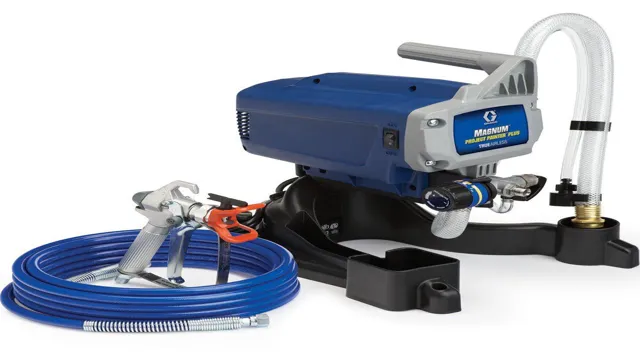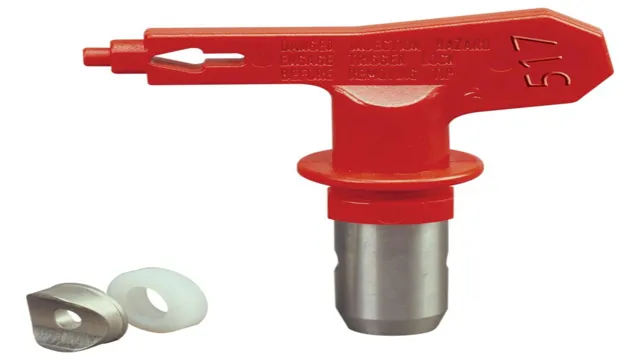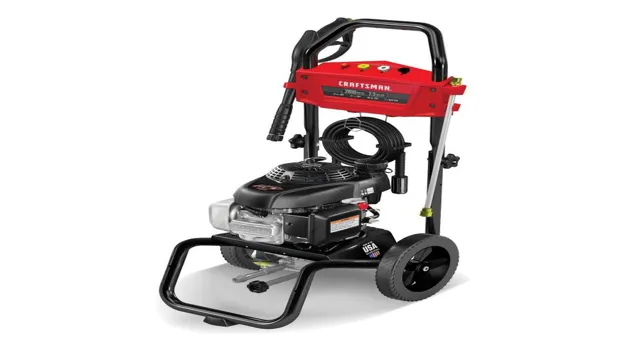How Easy Is It to Use a Paint Sprayer? Learn The Tips and Tricks for Effortless Application

Are you tired of struggling with traditional paint brushes and rollers for your home improvement projects? Look no further than a paint sprayer! Not only is it faster and more efficient, but it’s also surprisingly easy to use. Imagine being able to evenly coat a room in a fraction of the time it would take with a brush. With a paint sprayer, you can do just that.
It’s like upgrading from a bicycle to a sports car. So, let’s dive deeper into the question, “how easy is it to use a paint sprayer?”
Understanding Paint Sprayers
If you’re wondering whether using a paint sprayer is easy, the answer is it depends on your experience. For someone who has never used a paint sprayer before, getting the hang of it may take some time and practice. However, once you get the hang of how to operate it, using a paint sprayer is actually quite simple and efficient.
Paint sprayers, especially airless sprayers, are perfect for those who want to get a smooth, professional finish without the hassle of painting with a brush or roller. With the right technique and some patience, you can achieve a high-quality finish even on textured surfaces. So, if you’re willing to invest some time in practice and learning, using a paint sprayer can be an excellent way to save time and achieve professional-looking results.
Overall, the ease of using a paint sprayer depends on your willingness to learn and patience in mastering the technique.
Types of Paint Sprayers and Their Uses
Understanding Paint Sprayers Paint sprayers are essential tools for any DIY or professional painter. They are highly efficient and can save time and effort. There are different types of paint sprayers available in the market, and each one has its own unique set of uses.
The main types of paint sprayers are airless, HVLP and handheld. Airless paint sprayers are best for exterior painting, large surfaces, and commercial jobs. HVLP (High Volume Low Pressure) sprayers are ideal for smaller projects, fine finishes, and detail work.
Handheld paint sprayers are perfect for smaller scale work, touch-ups, and difficult to reach areas. Understanding the different types of paint sprayers is crucial as it will help you choose the right one for your specific needs. Once you have the right paint sprayer, you can achieve a professional finish faster and with less effort.
It’s important to follow the manufacturer’s instructions, wear safety gear, and practice before starting your project. With the right technique and equipment, you can achieve a flawless finish every time.

Benefits of Using a Paint Sprayer
Paint Sprayers If you’re thinking of giving your walls a fresh paint job or repainting your furniture, using a paint sprayer can be a game-changer. Paint sprayers are a tool that offers many benefits, including faster and more even coverage, saving time and effort. With a paint sprayer, you can achieve professional-looking results without the need for professional expertise.
Additionally, paint sprayers are suitable for indoor and outdoor use, making them versatile enough for various painting projects. Unlike traditional painting methods, paint sprayers can help you minimize overspray, drips, and mess, making them an efficient and cost-effective choice. With a paint sprayer, you can achieve detailed, crisp finishes that look like they were done by a professional.
So, if you’re looking for a tool that can help you achieve exceptional results with minimal effort and time, consider using a paint sprayer.
Using a Paint Sprayer
If you’ve never used a paint sprayer before, it may seem intimidating at first, but it’s actually quite easy to use with a little practice. First, make sure to choose the right spray tip for the job and adjust the pressure to match the coating you’re using. Next, start spraying in a fluid motion, moving the sprayer from side to side in a steady pattern.
To avoid drips or over-spraying, use light coats and keep the sprayer at a consistent distance from the surface you’re painting. With a little practice, you’ll soon find that using a paint sprayer is much quicker and more efficient than painting by hand, and you’ll be able to achieve a smooth, even finish on all your projects. So why not give it a try and see for yourself how easy it is to use a paint sprayer!
Preparing the Surface
When using a paint sprayer, it is crucial to prepare the surface properly, or else the paint won’t adhere well or will appear uneven. First, you should clean the surface to remove any dirt and debris. Then, sand it down using a fine-grit sandpaper to create a rough surface that the paint can grip onto.
Once that’s done, use a tack cloth to remove any dust or debris left behind from sanding. Finally, cover any areas or items nearby that you don’t want to get paint on, such as floors or furniture. By taking these steps, you can ensure a smooth and even coat of paint when using a paint sprayer, and avoid any unnecessary mess.
So, make sure to spend some time on preparing the surface before you start using the paint sprayer to get the best results.
Mixing and Pouring Paint
When it comes to using a paint sprayer for your home improvement projects, mixing and pouring paint is a crucial step that determines the final outcome. Before you start, make sure to choose the right paint and primer for your surface and conditions. Then, it’s time to mix the paint thoroughly to make sure it’s smooth and consistent.
You can use a drill mixer or a paint stirrer to blend the paint evenly. Once the paint is ready, pour it into the spray gun’s container and adjust the nozzle settings according to the surface’s texture and required finish. As you start spraying, keep the gun moving at a steady pace and maintain a consistent distance to avoid drips or uneven coverage.
With these tips in mind, you can enjoy a professional-looking finish and save time compared to traditional brush and roller techniques.
Adjusting the Sprayer Settings
Adjusting the sprayer settings is crucial if you want to achieve the best results when using a paint sprayer. Firstly, you need to choose the right nozzle size based on the type of coating you’re using. The wrong size can lead to an uneven finish, overspray, or an uneven coating thickness.
Once you have the right nozzle size, you can adjust the spray pattern and pressure to suit your project. For example, a vertical spray pattern is suitable for a large flat surface, while a horizontal spray pattern is ideal for a narrow surface like a cabinet. You should also adjust the paint flow rate based on the viscosity of your paint.
Too much flow rate can lead to drips and runs, while too little can result in a patchy finish. By taking the time to adjust your sprayer settings, you can make your painting project much easier and achieve a professional-quality finish.
Starting and Stopping the Sprayer
When using a paint sprayer, it’s important to know how to start and stop it properly. First, make sure the sprayer is plugged in and turned on. Then, with the nozzle pointed away from you and any surrounding objects, squeeze the trigger to test the spray and adjust the flow if necessary.
Once you’re ready to start spraying your surface, hold the sprayer about 6-8 inches away and move it in a steady back-and-forth motion, overlapping each pass slightly for an even coat. When you’re ready to stop or take a break, release the trigger and turn the sprayer off. Remember to clean the sprayer thoroughly before storing it, as any leftover paint can clog the nozzle and cause problems the next time you use it.
Whether you’re a professional painter or a DIY enthusiast, starting and stopping your paint sprayer correctly can save you time and hassle in the long run.
Painting Techniques
Paint sprayers are an excellent tool when it comes to painting projects. These devices are perfect for covering large areas and getting the job done quickly. When using a paint sprayer, it’s essential to ensure that the paint spray is evenly distributed and doesn’t overlap.
To do this, it’s vital to move your arm in straight lines and keep a consistent distance from the surface being painted. It’s best to start by testing the paint sprayer on a scrap piece of wood or cardboard, allowing you to adjust the settings and get a feel for the device. Additionally, always wear protective gear such as goggles, a mask, and gloves to avoid inhaling or getting paint on your skin.
By using a paint sprayer, you’ll have a faster and more efficient painting experience.
Cleaning and Maintenance
Using a paint sprayer can make painting large surfaces a breeze, but proper cleaning and maintenance are essential to keep your sprayer working at its best. After each use, make sure to flush the sprayer with water or cleaning solution to prevent paint buildup and clogs. Take apart any removable components, such as the nozzle, and clean them thoroughly with a brush or toothbrush.
Inspect the sprayer for any damage, such as cracks or leaks, before storing it. If you notice any issues, it’s best to address them before your next painting project. Regular maintenance, such as oiling moving parts and replacing worn or damaged components, can also prolong the life of your paint sprayer.
By following these simple steps, you can maintain and use your paint sprayer with ease and confidence for all your painting needs.
Conclusion
In conclusion, using a paint sprayer is like having a magic wand that transforms your walls, furniture, or even your car into a new and refreshing look. Is it easy peasy lemon squeezy? Well, let’s put it this way: with the right technique, a steady hand, a bit of practice, and some patience, you can achieve professional-grade results without breaking a sweat. Plus, you’ll enjoy the added benefits of saving time, minimizing mess, and enhancing the overall quality of your project.
So why settle for dull brushes or rollers when you can level up your DIY game with a paint sprayer? Give it a go and see how easy or, dare I say, how much fun it can be!”
FAQs
What are the advantages of using a paint sprayer over traditional brush and roller methods?
Paint sprayers produce a smoother finish, require less effort and time, and can cover larger surface areas more quickly.
Can a beginner use a paint sprayer, or is it only recommended for professionals?
A beginner can use a paint sprayer with proper instruction and practice. Many sprayers come with instructions and tutorials for first-time users.
Are all paint sprayers the same, or do they come in different types for specific applications?
Paint sprayers come in different types such as airless, HVLP, and pneumatic, and each is designed for specific applications and finishes.
Is it necessary to thin paint before using a paint sprayer?
It depends on the paint thickness and the type of sprayer being used. In some cases, thinning the paint may be necessary to ensure a smooth finish and prevent clogging.
Can a paint sprayer be used for outdoor projects, such as painting a fence or deck?
Yes, paint sprayers can be used for outdoor projects and are ideal for covering large surfaces quickly and evenly.
How do you clean a paint sprayer after use?
The cleaning process varies depending on the type of sprayer, but generally involves flushing the sprayer with water or a cleaning solution to remove any leftover paint.
What safety precautions should be taken when using a paint sprayer?
Protective gear, such as goggles and a respirator, should be used to avoid inhaling paint particles. Other precautions include covering nearby objects, ventilating the area, and turning off the power when changing or cleaning the sprayer.







